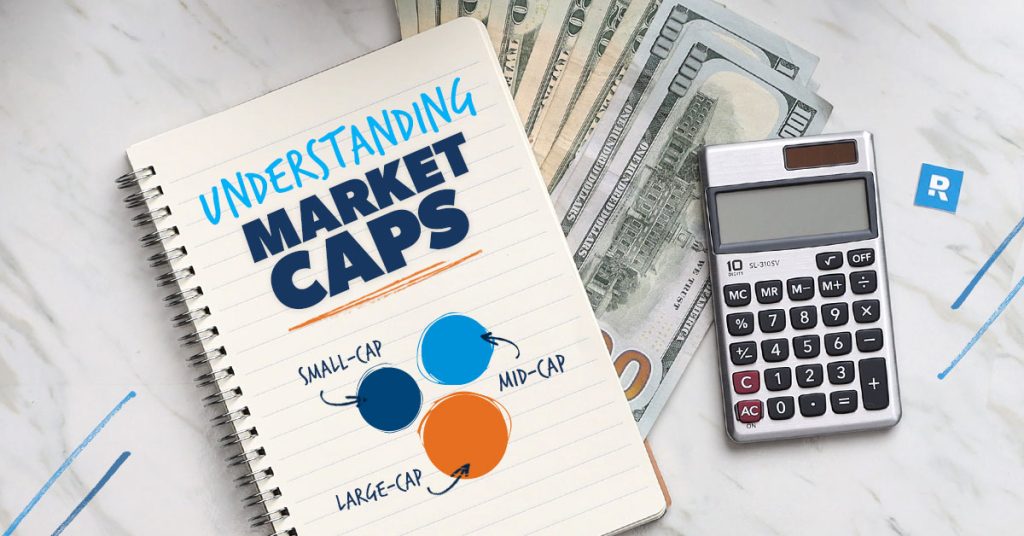Ever been at a dinner party where someone started using fancy investing terms that made everyone feel intimidated? One of the things we love doing is helping people understand complicated investing topics. And market capitalization is one of those $20 words that we like to explain in simple terms.
Let’s take a closer look.
What Is Market Capitalization?
Market capitalization, or “market cap,” basically means the total value of all a company’s stock. While we’ll never tell you to purchase a single company’s stock, it’s good to know the market capitalization of the companies inside the growth stock mutual funds that make up your portfolio. We want you to understand market caps so you can build wealth and make your retirement dreams a reality!
Why Is Market Cap Important?
Market capitalization is important because it lets you, as an investor, understand the relative size of one company versus another. It measures what a company is worth on the open market, and what investors are willing to pay for its stock. A lot of people mistake a company’s stock price as a representation of its valuation (how much it’s worth), health and stability. They think a higher stock price shows a company’s strength, or they look at a lower priced stock as a bargain investment.
Ah, but there’s more to it than meets the eye—stock price alone doesn’t represent a company’s actual worth! That’s where market capitalization comes in handy. It’s the better measure because it represents the true value of the company in the overall market.
Let’s look at an example and do the old soft drink taste test, except with market cap instead of flavor. As of fall 2020, PepsiCo, Inc. had a stock price of $139 while Coke’s was $49. But Coke’s market cap is north of $220 billion while Pepsi’s is just over $188 billion.1,2 Comparing the two companies by solely looking at their stock prices does not give a true representation of their actual value.
A high stock price in and of itself does not always indicate a healthy or growing company. It can still have a relatively small market cap!
Market cap values also heavily influence a lot of the top market indexes. For example, the S&P 500 index includes the top 500 U.S. companies that are weighted based on their market cap value. Indexes like this not only represent the overall market trends and attitudes, but they’re also used as benchmarks to track the performance of various funds, portfolios, and individual investments. Think of index funds like a yardstick. They’re a standard unit of measurement that you can use to measure other things.
Why Are There Different Size Caps?
Like baseball cap sizes, companies are categorized based on sizes called “caps”—large, mid and small.
Large-Cap
These come with a market value of $10 billion or more. Large-caps often have a reputation for producing quality goods and services, a history of consistent dividend payments, and steady growth. They’re the dominant players within established industries, and their brand names typically ring a bell with most people (think: Amazon, Microsoft, JPMorgan Chase).
Investments in large-cap stocks are considered “safer” than investments in small-cap or mid-cap stocks because they generally pose less risk. The tradeoff, though, is that there’s also less growth potential.
Mid-Cap
Typically, this category includes businesses with a market value of $2–$10 billion. Most are established companies in industries that are experiencing, or are expected to experience, rapid growth (Five Below, Levi Strauss, Scotts Miracle-Gro). These medium-size companies may be in the process of increasing their market share and improving their overall competitiveness. The mid-cap growth stage helps determine whether or not a company will join the large-cap “heavy hitters.”
Market chaos, inflation, your future—work with a pro to navigate this stuff.
Mid-cap stocks generally fall between large-caps and small-caps on the risk/return spectrum. They’re generally expected to offer more growth potential than large-caps, and possibly carry less risk than small-caps.
Small-Cap
Small-caps have a market value of $300 million to $2 billion. Generally, these are comparatively young companies (iRobot, Buffalo Wild Wings, Ancestry.com) that serve niche markets or emerging industries. Small-caps are considered the most aggressive—and riskiest—of the three cap sizes. The relatively limited resources of small companies can make them less protected if there were a business or economic downturn. They may also be vulnerable to the intense competition and uncertainties that come with untested, growing markets.
Long-term investors can turn a big profit by investing in small-cap funds—if they’re willing to ride out the crazy highs and lows of the stock prices. See what we mean by risky?
As companies grow, they can transition from small to mid to large cap depending on changes in their market cap valuations. Along with companies, other popular investments like mutual funds and exchange-traded funds (ETFs) are also categorized as small-cap, mid-cap or large-cap. In the case of funds, the terms represent the types of stocks the fund holds.
Why Does Size Matter?
Generally speaking, the larger a company is, the more money they have to “play” with. Coca Cola can invest a few hundred million in a new venture (a business term for “trying something new”) and if it fails, then it’s not going to impact their bottom line all that much. However, a mid-cap company making a similar value investment may take a big blow if their venture fails because they don’t have that bigger cushion to absorb the financial blow. If the venture succeeds for large-cap companies, it may look like a blip on their profit numbers. On the other hand, a win like that for a mid-cap company could catapult its valuations way up.
Valuations of mid-cap or small-cap companies often take the hit when there are reports of a large-cap company invading their space of products or services. Look at what Amazon has done to change our shopping habits and force other online companies to adjust their business models.
What Impacts Market Cap?
Okay, there are a couple of factors that help determine a company’s market cap. The two most important factors are 1) changes in the value of a company’s shares and 2) the number of shares issued. The best examples of this are when a company issues new stock or repurchases shares—known as a buyback.
When a company raises money by issuing new shares, it’s normally to buy other assets, or even another company. This improves the outlook on the company, so the stock price goes up and the market cap rises with a higher price and more shares. In a buyback, the market cap decreases because the company spends a ton of cash buying back its own shares (which lowers their cash on hand) and because there are now fewer shares available but share prices have stayed the same (which lowers the company’s valuation). You still with me here?
A third way to alter market cap is an exercise of warrants. No, we’re not talking about people getting arrested! This type of warrant gives you the right to purchase a company’s stock at a specific price on a specific date, and increases the outstanding shares of a company’s stock. The exercise of the warrants is typically done below the market price of the shares. So, guess what happens to the stock? It decreases in value, and could potentially impact the company’s market cap.
Bottom Line
Again, we never recommend the eggs-in-one-basket approach of putting money in single stocks. Investing 15% of your hard-earned money in a mix of growth stock mutual funds within employer-sponsored plans (401(k), 403(b)) and Roth IRAs is the best way to reach your retirement dreams. But understanding market cap, and how it applies to your investments, can help you know which of those growth stock mutual funds are the best options.
Get With a SmartVestor Pro
Understanding market cap, and how it applies to your investments, may not be your cup of tea. It’s always a good idea to sit down with an investing professional, like a SmartVestor Pro, who can help you understand the market and help you set goals for your financial future.
Find a SmartVestor Pro today!
Read the full article here










